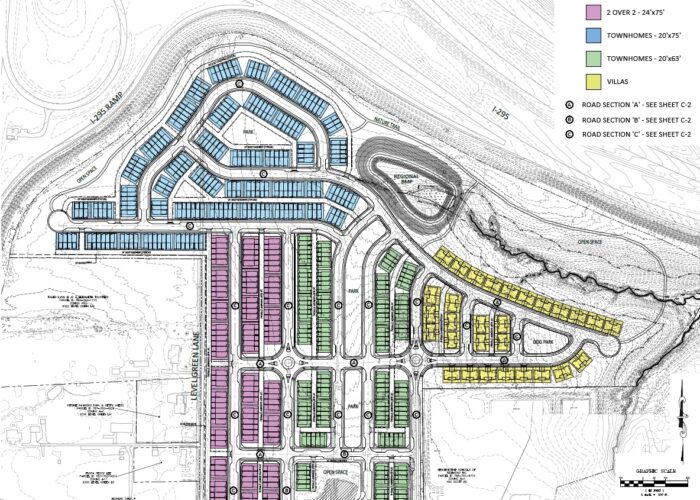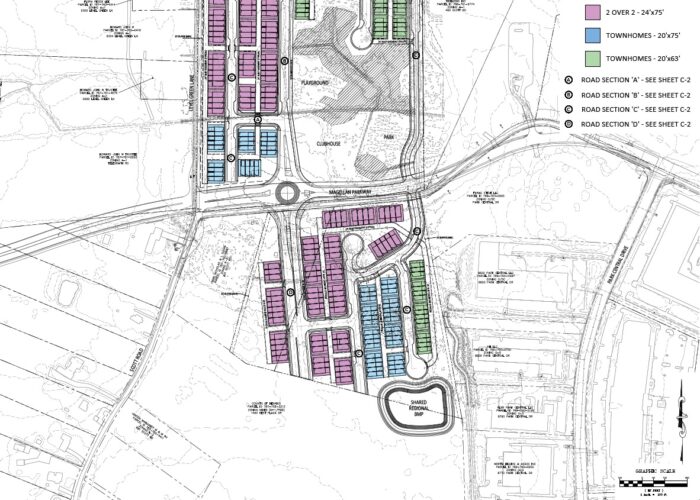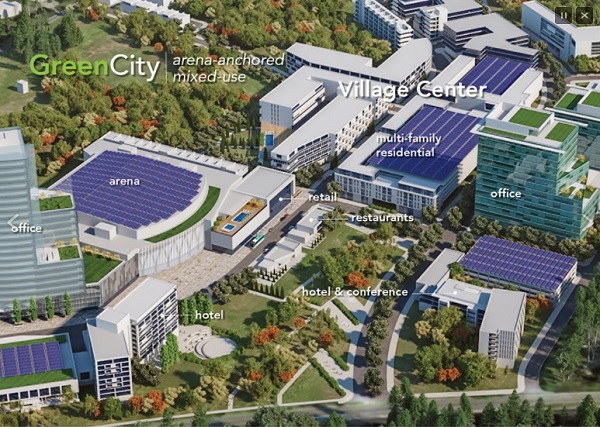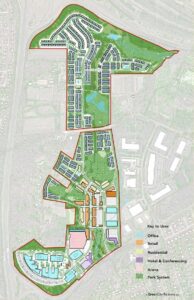
A conceptual layout, shown in halves above and below, illustrates residential development planned for the 104-acre Scott Farm property that makes up the northern half of the GreenCity site. (Henrico documents)

As the developer behind the massive GreenCity project prepares to break ground on an initial phase later this year, the current owner of the rest of the project site is making preparations for development of that land as well.
Riverstone Properties, the Bill Goodwin-owned firm, has filed a planning application with Henrico County showing a conceptual layout for residential development of the 104 acres it owns that make up the northern half of the larger GreenCity site.
The roughly 200-acre site, which includes the 93-acre former Best Products property, stretches from East Parham Road to Interstate 295 along the east side of I-95. The $2.3 billion project, to be anchored by an arena, would fill the site with a mix of development including office and retail space, two hotels, green space and up to 2,400 residential units.
Riverstone’s layout, which is subject to change, deviates slightly from a larger conceptual site plan that developer GreenCity Partners shared when the project was announced in 2020. It also specifies the types of residential development planned for the Riverstone land, which GreenCity Partners would eventually purchase.
The application states that Riverstone “would like feedback on the layout and road sections in anticipation of our filing the preliminary plat application.” It adds that the company also would like to go over process questions with the county for getting approvals for construction, and notes that discussions already are occurring with county transportation and public utilities staff.
The layout shows a mix of “two-over-two”-style condos, townhomes and villa-style homes filling the bulk of the land, known as Scott Farm.
Nearly 200 of the larger-sized townhomes, with footprints of 20-by-75 feet, would fill the northernmost corner beside the 95-295 interchange, while the condos and smaller 20-by-63-foot townhomes would form the spine of the linear-shaped site.
A line of parks and open space would create a greenway between the smaller townhomes, leading to amenities including a clubhouse, playground and park. The villas, which appear to be duplex-style homes, would be grouped in the northeast corner of the site, where a nature trail and open space are planned along 295.
More condos and townhomes would fill the southern end of the site, across a planned extension of Magellan Parkway that would bisect GreenCity along the existing east-west alignment of Scott Road. A roundabout on the parkway would connect the two ends.
The layout also shows a dog park within the villas section, while a similar-sized park is planned near the larger townhomes at the northern end. The layout was drawn up by local firm Townes Site Engineering.
The application does not specify unit counts for the housing types. A count by BizSense of the units shown on the layout put the totals at 440 condos, 253 larger townhomes, 169 smaller townhomes and 58 villa units, or 920 units overall. While the layout shows 220 condo plats, the number of units would be double that figure because they’re two-over-twos, meaning a two-floor unit on top of a two-floor unit.
The 920-unit total is less than half of the 2,400-unit maximum approved for GreenCity. The difference would be made up by additional residential development planned for the former Best Products site, as is reflected on the project’s conceptual site plan.
Calls to Riverstone Properties’ Chris Corrada and GreenCity Partners’ Michael Hallmark were not returned Wednesday.

A conceptual rendering shows the arena in relation to other buildings in the proposed GreenCity mixed-use development.
While the layout shows what’s envisioned for Scott Farm, the initial phase of development for GreenCity is slated to focus on the Best Products site, with a repurposing of the 300,000-square-foot former headquarters building and development of a 17,000-seat arena that would effectively replace the shuttered Richmond Coliseum.
Overall, in addition to the arena, GreenCity is approved for 2.2 million square feet of office space, 280,000 square feet of retail and two 300-room hotels, along with the 2,400 residential units and green space.
The Best Products building rehab is slated for completion in 2024, while the arena, the first of the two planned hotels and other initial development are targeted for completion in 2025. Full buildout of the entire GreenCity project is anticipated in 2033.
Last month, Henrico supervisors formed a community development authority to help finance the initial phase. The CDA would issue 30-year bonds to finance a portion of the arena and infrastructure improvements within the Best Products site. Tax revenue generated from that phase along with revenue generated from the arena would be used to pay off the bonds.
The county also amended a purchase agreement that allows GreenCity Partners to buy the county-owned Best Products site in three installments over a two-year period. The agreed-upon price remains $6.2 million – the amount the county paid for the property in 2011.
The first installment of $500,000 is due Feb. 28, while another $500,000 would be paid 12 months after that. The remaining balance of $5.22 million is to be paid 12 months after that, in February 2025.
GreenCity Partners also would purchase Scott Farm from Riverstone, which bought that land in 2015 for more than $6.4 million. A Riverstone representative in 2020 said the purchase would be contingent on rezoning, which the county approved in 2021, and could involve all or some portion of the land. Henrico has assessed the three parcels that make up the acreage at over $15.7 million.

A conceptual layout, shown in halves above and below, illustrates residential development planned for the 104-acre Scott Farm property that makes up the northern half of the GreenCity site. (Henrico documents)

As the developer behind the massive GreenCity project prepares to break ground on an initial phase later this year, the current owner of the rest of the project site is making preparations for development of that land as well.
Riverstone Properties, the Bill Goodwin-owned firm, has filed a planning application with Henrico County showing a conceptual layout for residential development of the 104 acres it owns that make up the northern half of the larger GreenCity site.
The roughly 200-acre site, which includes the 93-acre former Best Products property, stretches from East Parham Road to Interstate 295 along the east side of I-95. The $2.3 billion project, to be anchored by an arena, would fill the site with a mix of development including office and retail space, two hotels, green space and up to 2,400 residential units.
Riverstone’s layout, which is subject to change, deviates slightly from a larger conceptual site plan that developer GreenCity Partners shared when the project was announced in 2020. It also specifies the types of residential development planned for the Riverstone land, which GreenCity Partners would eventually purchase.
The application states that Riverstone “would like feedback on the layout and road sections in anticipation of our filing the preliminary plat application.” It adds that the company also would like to go over process questions with the county for getting approvals for construction, and notes that discussions already are occurring with county transportation and public utilities staff.
The layout shows a mix of “two-over-two”-style condos, townhomes and villa-style homes filling the bulk of the land, known as Scott Farm.
Nearly 200 of the larger-sized townhomes, with footprints of 20-by-75 feet, would fill the northernmost corner beside the 95-295 interchange, while the condos and smaller 20-by-63-foot townhomes would form the spine of the linear-shaped site.
A line of parks and open space would create a greenway between the smaller townhomes, leading to amenities including a clubhouse, playground and park. The villas, which appear to be duplex-style homes, would be grouped in the northeast corner of the site, where a nature trail and open space are planned along 295.
More condos and townhomes would fill the southern end of the site, across a planned extension of Magellan Parkway that would bisect GreenCity along the existing east-west alignment of Scott Road. A roundabout on the parkway would connect the two ends.
The layout also shows a dog park within the villas section, while a similar-sized park is planned near the larger townhomes at the northern end. The layout was drawn up by local firm Townes Site Engineering.
The application does not specify unit counts for the housing types. A count by BizSense of the units shown on the layout put the totals at 440 condos, 253 larger townhomes, 169 smaller townhomes and 58 villa units, or 920 units overall. While the layout shows 220 condo plats, the number of units would be double that figure because they’re two-over-twos, meaning a two-floor unit on top of a two-floor unit.
The 920-unit total is less than half of the 2,400-unit maximum approved for GreenCity. The difference would be made up by additional residential development planned for the former Best Products site, as is reflected on the project’s conceptual site plan.
Calls to Riverstone Properties’ Chris Corrada and GreenCity Partners’ Michael Hallmark were not returned Wednesday.

A conceptual rendering shows the arena in relation to other buildings in the proposed GreenCity mixed-use development.
While the layout shows what’s envisioned for Scott Farm, the initial phase of development for GreenCity is slated to focus on the Best Products site, with a repurposing of the 300,000-square-foot former headquarters building and development of a 17,000-seat arena that would effectively replace the shuttered Richmond Coliseum.
Overall, in addition to the arena, GreenCity is approved for 2.2 million square feet of office space, 280,000 square feet of retail and two 300-room hotels, along with the 2,400 residential units and green space.
The Best Products building rehab is slated for completion in 2024, while the arena, the first of the two planned hotels and other initial development are targeted for completion in 2025. Full buildout of the entire GreenCity project is anticipated in 2033.
Last month, Henrico supervisors formed a community development authority to help finance the initial phase. The CDA would issue 30-year bonds to finance a portion of the arena and infrastructure improvements within the Best Products site. Tax revenue generated from that phase along with revenue generated from the arena would be used to pay off the bonds.
The county also amended a purchase agreement that allows GreenCity Partners to buy the county-owned Best Products site in three installments over a two-year period. The agreed-upon price remains $6.2 million – the amount the county paid for the property in 2011.
The first installment of $500,000 is due Feb. 28, while another $500,000 would be paid 12 months after that. The remaining balance of $5.22 million is to be paid 12 months after that, in February 2025.
GreenCity Partners also would purchase Scott Farm from Riverstone, which bought that land in 2015 for more than $6.4 million. A Riverstone representative in 2020 said the purchase would be contingent on rezoning, which the county approved in 2021, and could involve all or some portion of the land. Henrico has assessed the three parcels that make up the acreage at over $15.7 million.




At this point, I’m not even trying to understand the massive logistics of this development. Just excited to see it come together over the next few years.
I can’t determine where the parking will be located to accommodate 17,000. fans for a game or a concert. From what I can see it appears that there will be gridlock before and after an event. Even if there were 4 people per vehicle that would mean there would be 4,250 cars to deal with!
There’s literally nowhere with a better traffic management plan. From the site; traffic dumps out onto Parham Road, which is a 4 lane, signalized, divided roadway. Then, there is only ~500 ft from Parham Road to the entrance ramp to I-95. Technically traffic can be split, turning left onto Parham to funnel to 301/295 or turning right to 95. There will also likely be heavy investment on mass transportation and shuttle transportation to/from this site for larger events. Development considerations should not revolve around the assumption of 100% private car usage. That is a dying mentality. For perspective, car ownership… Read more »
So, there is some form of alternative transportation in this area?
As of now, no – and that needs to be worked into the equasion. GRTC and the CVTA have been working on plans to expand the PULSE BRT system (not just running the existing PULSE Broad Street line to Short Pump – but also developing a primary north-south BRT line with a terminus at the former former Virginia Center Commons). If Green City indeed becomes a realtiy, (and I 100% hope it does!) the transit agencies would be well served to consider adjusting their proposed routing to include (or to begin/end in) Green City. Absent BRT connecting with Green City,… Read more »
GRTC outlined a plan that prioritized expansion of bus service to the Parham and Brook Road corridor as early as next year. Publicly, it is their second highest priority immediately after a line extension down Midlothian Tpke.
Development of “Green City” is specifically listed as the catalyst for this priority.
Details can be found with a media release found here: http://ridegrtc.com/media/main/Board_Update_on_Expansion_Priorities_and_Micro_Transit_Pilot.pdf
Spot on, Zachary, particularly to your last paragraph. VERY well said. The time is long overdue for metro Richmond to step up and join the ranks of other mid-sized and large cities that are moving (even if only incrementally) away from complete, 100% car-centric development. Henrico County has been quite correctly embracing significantly higher densities in current and planned developments in this (the northern) part of the county as well as throughout the West End. Readers of this publication who have been following developments in norther Henrico surely are aware that a number of moderate and higher density developments are… Read more »
Brian, in addition to what readers are mentioning (below) regarding the inclusion of mass and even rapid transit as part of an overall approach to planning a development of the magnitude of Green City, how about we wait for the county and/or developers to provide us with an equally granular look at the southern half of the overall development before worrying about where fans attending events at the new arena will park? Honestly, worrying where people will park when as of yet we don’t have anything approaching a complete picture, particularly at a granular level, of how this development will… Read more »
What a disjointed article. Riverstone / Bill Goodwin files for a Residential Development on Scott Farm and then at the end of the article it is stated: “GreenCity Partners also would purchase Scott Farm from Riverstone, which bought that land in 2015 for more than $6.4 million.” Why would Goodwin develop his site if it’s going to be sold to Green City Partners?
Green City Partners is run by the same two who just gave back to the City of Richmond the Public Safety Building after it failed to take the necessary steps required to develop the site.